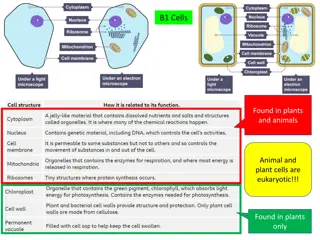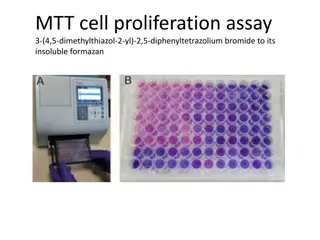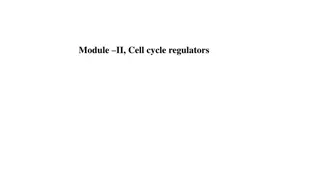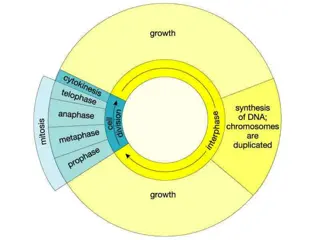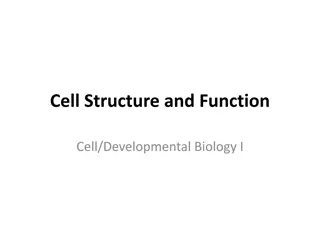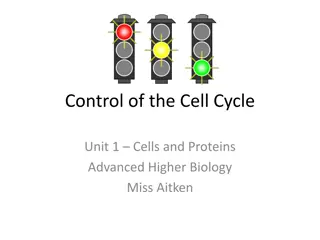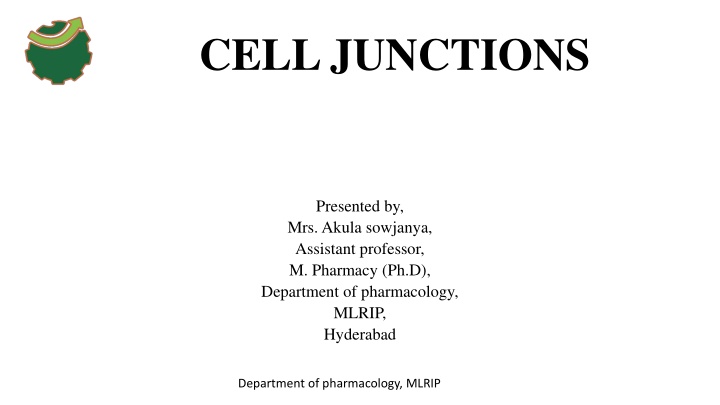
Cell Junctions
Learn about the significance of cell junctions in connecting neighboring cells and regulating intercellular exchanges. Explore the functions and characteristics of occluding (tight), communicating, and gap junctions in maintaining tissue integrity and facilitating molecular movement. Discover how tight junctions form the blood-brain barrier and how gap junctions allow direct molecule transfer between cells without extracellular contact.
Download Presentation

Please find below an Image/Link to download the presentation.
The content on the website is provided AS IS for your information and personal use only. It may not be sold, licensed, or shared on other websites without obtaining consent from the author. If you encounter any issues during the download, it is possible that the publisher has removed the file from their server.
You are allowed to download the files provided on this website for personal or commercial use, subject to the condition that they are used lawfully. All files are the property of their respective owners.
The content on the website is provided AS IS for your information and personal use only. It may not be sold, licensed, or shared on other websites without obtaining consent from the author.
E N D
Presentation Transcript
CELL JUNCTIONS Presented by, Mrs. Akula sowjanya, Assistant professor, M. Pharmacy (Ph.D), Department of pharmacology, MLRIP, Hyderabad Department of pharmacology, MLRIP
Cell junctions Cell junction is the connection between neighboring cells. The contact between the cell and extracellular matrix is called membrane junction. 3 types- occluding junctions(tight junction), communicating junctions, anchoring junctions. Department of pharmacology, MLRIP
C Occluding junctions: Cell junctions which prevent intercellular exchange of substances are called occluding junctions. i.e these junction prevent the movement of ions and molecules from one cell to another cell----Tight junction. 1. Tight junction is made up a ridge which has two halves. 2. One half of the ridge is from one cell and another half is from the other cell. 3. Both halves of the ridge fuse with each other very tightly and occupy the space between the two cells. 4. Present in apical margins of epithelial and endothelial cells in intestinal mucosa, walls of renal tubules, capillary wall. Department of pharmacy practice, MLRIP
C Department of pharmacy practice, MLRIP
Tight junction-Functions Provide the strength and stability to the tissues Tight junction act as gate regulate the interchange of ions, water, varieties of macromolecules between cells. Tight junction prevents the lateral movements of proteins and lipids in cell membrane. Tight junction in the brain capillaries forms the BBB, which prevents the entrance of many substances from capillary blood in to brain tissues. only lipid soluble substances crosses the BBB Department of pharmacology, MLRIP
Communicating junctions Cell junctions which permits the intracellular exchange of substances are called communicating junctions These junctions permit the movement of ions and molecules from one cell to another cell. a. Gap junction b. Chemical synapse Department of pharmacy practice, MLRIP
Gap junction Present in heart, epithelial cells of intestinal mucosa Membrane of two cells lie very close to each other. Intercellular space-2.5-3.0nm The cytoplasm of two cells are connected by the gap channels formed by the membranes of both cells So, movement of molecules from one cell to another cell directly through these channels without contact with ECF Each channel consists of two half's, each half belongs to one of the two adjacent cells Each half of the channel surrounded by 6 subunits of proteins, which are called connexions or connexons Department of pharmacology, MLRIP
Gap junction Department of pharmacology, MLRIP
Gap junction-Functions Channel permits the passage of glucose, AA, ions, other substances, mol wt less than 1000 daltons Helps in exchange of chemical messenger between cells Helps in rapid propagation of A.P from one cell to another cell. Department of pharmacology, MLRIP
b. Chemical synapse: is the junction between nerve fiber and muscle fiber or between two nerve fibers through which signals are transmitted by the release of chemical transmitters. Department of pharmacology, MLRIP
Anchoring Junction Anchoring junctions are the junctions that provide strength to the cells by acting like mechanical attachment, i.e these junctions provide firm structural attachment between two cells or b/w cells and extracellular matrix AJ responsible for the structural integrity of the tissues Present in the tissues like heart muscles, epidermis of skin AJ are classified into 2 types 1. Actin filament Attachment: a. Adherence junction, b. Focal junction 2. Intermediate filament Attachment: a. Desmosome b. Hemidesmosome Department of pharmacology, MLRIP
Adherens junction: is the cell to cell junction. Which connects the actin filaments of one cell to another cell In AJ junction, the cell membrane of two cells are held together by some transmembrane proteins called cadherins This junction provide strong mechanical attachment between two cells Present in the intercalated disc between branches of cardiac muscles During contraction and relaxation of cardiac muscles fibers are held together tightly by means of this junction. Department of pharmacology, MLRIP
Focal Adhesion: is the cell to matrix junction, which connects the actin filaments of the cell to the extracellular matrix The transmembrane proteins, which holds the cell membrane and the matrix are called integrins Department of pharmacology, MLRIP
Intermediate filament attachment: a. Desmosome (macula adherens): is a cell to cell junction, where intermediate filaments connects two adjacent cells. b. Hemidesmosomes: is a cell to matrix junction, which connects the intermediate filaments of the cell to the exrtracellular matrix Department of pharmacology, MLRIP







